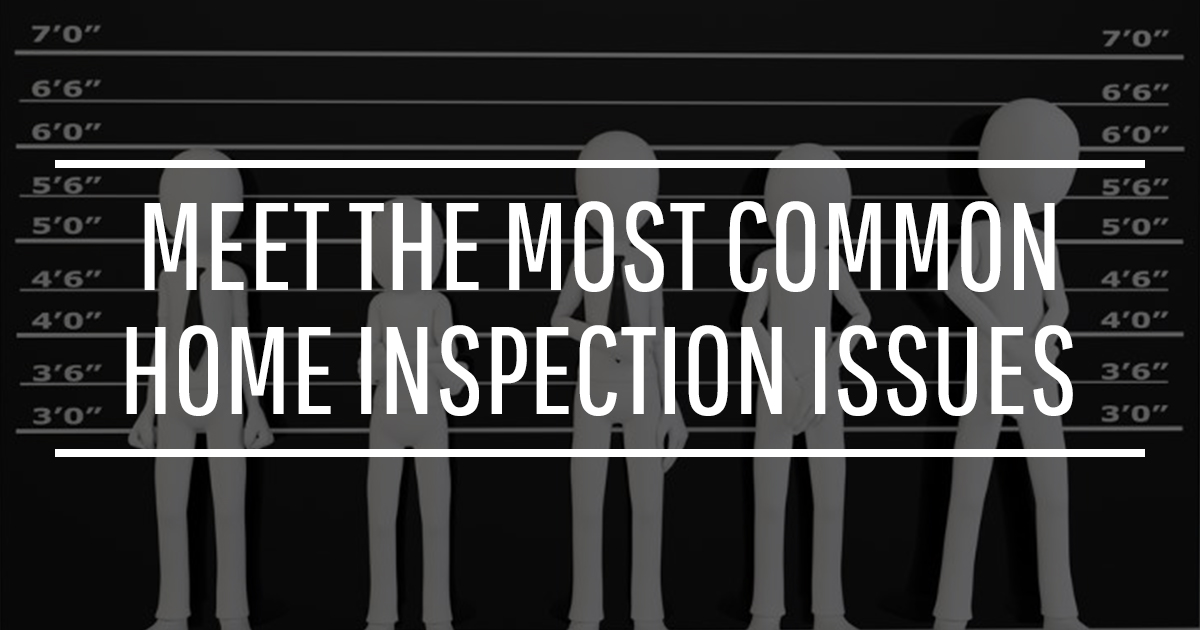As you already know, home inspections are pivotal for homeowners and are typically an important part of real-estate transactions. Often times, a transaction can’t be completed until the home has undergone a successful home inspection.
Home inspections can provide homeowners with added peace of mind that their home is less likely to suffer from preventable damage. For those of you who have had a home built, unfortunately your home is not exempt from these issues.
Sellers can use a good home inspection as a bargaining chip during sales negotiations for the home. Sometimes, home inspectors are more likely to come across certain problem areas than others. Below, you’ll find a list of the top 10 most common issues I have run across in the last 13 years of doing home inspections.
1. Poor Drainage:
The signs of poor drainage include signs of spongy, soft soil growing around the foundation of the home and erosion from rain running off the roof. Poor drainage can make the supporting soil around the foundation weak and cause mild to severe cracking in stucco and the possibility of water intrusion into the home at the foundation. The rain should have a gentle slope away from the foundation with gutters on the home so that the rain runoff from the roof doesn’t land next to the foundation.
2. Roof Issues:
With the harsh weather we have in Florida, roofs do not last as long as they do in other parts of the country. The sun and high winds cause the shingles to start failing around 15 years even with a 40-year shingle. Missing shingles from high winds blowing them off the roofs or damaging them, expose the roof to leaking. With the excessive temperature range, we have in a single day, the nails from the shingles expand and contract with the temperature and force their way through the shingles allowing for rain to enter the roof through the nail hole. Tile roofs have other issues as in cracking and sliding and need to be reset as necessary. Roofing issues should be realized and fixed as soon as possible. They are most common following inclement weather. After a storm or serious wind, roofing issues can nearly be anticipated on older roofs.
3. Poor Ventilation:
Florida is an extremely hot region of the country, If the attic gets too hot, the temperature may bleed through the ceilings into the home making the home hot. The increased temperature will also cause the shingles to fail quicker from the tar in the shingles bubbling or what is called blistering. This usually means that there are roof soffits that are blocked or the roof needs more vents.
4. Faulty Foundation
In Florida, the foundation is more than likely on the sand. Unlike dirt that can be packed and the concrete poured on a solid surface of dirt, sand cannot be compacted. When the concrete is poured over the sand, the sand shifls and moves and the sand moving under the concrete combined with the drying process of the concrete slab, the foundation cracks. It is typical in almost every home in Central Florida. Most of the time this does not cause issues but if the cracks become to severe, or if water is gathering at the foundation, hydrostatic pressure (ground water) may be pushed up through the cracks, or in worst case scenario, structural damage to the foundation and walls may occur..
5. Hazardous Wiring
Wiring is a very commonly found issue when completing home inspections. Many people think they know enough about wiring to do it themselves and cause many issues like outlets being wired wrong, Breakers in the panel box being double tapped, or leaving open junctions of exposed wires in various places. Faulty wiring is also dangerous, and puts your whole family at risk which is why you should have faulty wiring fixed as soon as it’s spotted.
6. Heating/Cooling
The heating and cooling systems are a typical area for problems during home inspections. The most common issue with heating systems during home inspections is that they are dirty because of not changing the filter when it is supposed to be. The best way to keep your system in good order is to put your system on a maintenance schedual. One of the biggest problems is when the air handler is in the attic or the garage. The air handlers are not air tight so the leaking cold air mixes with the attic and garage hot air causing condensation. This will promote rusting of the unit as well as water damage to the support box. There is also a high potentional for mold to grow in the unit due to the high humidity.
7. Windows
During a home inspection, windows should be checked to ensure they are operating properly and are sealed/caulked, especially in an older home. In Florida, the windows are rarely opened due to the heat and humidity. This will make the windows sticky and also cause the hardware to rust. Windows that are not caulked properly will have the exterior hot air mix with the inside air conditioned air and cause moisture at the window causing mold/mildew and even water damage at the areas of the windows.
8. Chimney/Fireplace
Fireplaces and chimneys are another area of the home that is prone to problems because of neglect. Chimneys & fireplaces should have their own inspections to prevent issues that could lead to water intruding a home due to chimney flashing or improper/rusted chimney caps. Other issues that homeowners face when dealing with chimneys include cracked tiles, rusted flues, and missing chimney caps.
9. Exterior neglect
General poor upkeep of the home is another critique found during home inspections. Poor upkeep can cause wood decay on unpainted/uncaulked wood. Plants and trees that are in contact with the home can also cause damage to the roof and exterior. Areas of walkways over time settle or are lifted by tree roots and cause trip hazzards.
10. Plumbing
The plumbing should be closely monitored. Water is very destructive to a home. All plumbing pipes leak due to different issues with each kind of piping. Faucet handles wear out over time and leak as well. Many people don’t know that when you install a toilet, the toilet should be sealed to the floor with adhesive caulk to keep the toilet from moving and leaking. The shower tiles missing or having cracked grout is also an area of concern as water can get behind the tiles and cause water damage and mold issues. With a thorough inspection all the plumbing fixtures should be inspected.


0 Comments